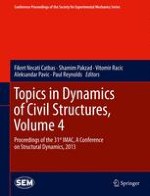Topics in Dynamics of Civil Structures, Volume 4: Proceedings of the 31st IMAC, A Conference and Exposition on Structural Dynamics, 2013, the fourth volume of seven from the Conference, brings together contributions to this important area of research and engineering. The collection presents early findings and case studies on fundamental and applied aspects of Structural Dynamics, including papers on:
Modal Parameter Identification for Civil Structures
Vibration Control of Civil Structures
Cable Dynamics
Damage Detection Models for Civil Structures
Data-Driven Health Monitoring of Structures & Infrastructure
Experimental Techniques for Civil Structures
Human-induced Vibrations of Civil Structures
Structural Modeling for Civil Structures
